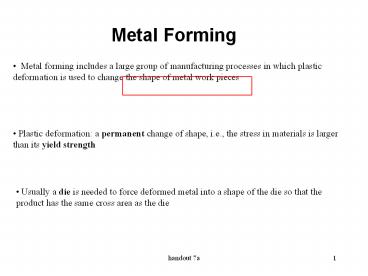Metal Forming PowerPoint PPT Presentation
1 / 17
Title: Metal Forming
1
Metal Forming
- Metal forming includes a large group of
manufacturing processes in which plastic
deformation is used to change the shape of metal
work pieces
- Plastic deformation a permanent change of
shape, i.e., the stress in materials is larger
than its yield strength
- Usually a die is needed to force deformed metal
into a shape of the die so that the product has
the same cross area as the die
2
Metal Forming
- Metal with low yield strength and high ductility
is in favor of metal forming
- One important difference between plastic forming
and metal forming is
Plastic solids are heated up to be polymer melt
Metal solid remains a solid state in the whole
process
3
Metal Forming
Metal forming is divided into (1) bulk and (2)
sheet
Bulk (1) there is a significant deformation
(2) there is a massive shape change
(3) surface area to volume of the work is small
Sheet Surface area to volume of the work is large
4
Bulk deformation processes
Forging
Rolling
Traditionally Hot
Extrusion
Drawing
5
Sheet deformation processes (Press working/
Stamping)
Drawing
Bending
Shearing
Actually Cutting
6
In the following series of lecture, we discuss
- For general metal forming process, general
mechanics principle / law / effect - For individual processes
- - mechanics principles
- - design for manufacturing (DFM) rules
- - equipment
7
1. General mechanics principle
- The underlying mechanics principle for metal
forming is the stress-strain relationship see
Figure 1.
Figure 1
8
- True Stress Applied load divided by
instantaneous value of cross-section area
- True strain Instantaneous elongation per unit
length of the material
9
- In the forming process we are more interested in
the plastic deformation region (Figure 1)
Plastic deformation region
10
- The stress-strain relationship in the plastic
deformation region is described by
Where K the strength coefficient,
(MPa) ? the true strain, sthe true
stress n the strain hardening
exponent,
The flow stress (Yf) is used for the above stress
(which is the stress beyond yield)
11
FLOW STRESS
- As deformation occurs, increasing STRESS is
required to continue deformation
- Flow Stress Instantaneous value of stress
required to continue deforming the material
(i.e., to keep metal flowing)
12
AVERAGE FLOW STRESS
- For many bulk deforming processes, rather than
instantaneous stress, average stress is used
(extrusion)
- The average flow stress can be obtained by
integrating the flow stress along the trajectory
of straining, from zero to the final strain value
which defines the range of interest
Strength Coefficient
Max. strain during deformation
Average flow stress
Strain hardening exponent
13
Example 1 Determine the value of the
strain-hardening exponent for a metal that will
cause the average flow stress to be
three-quarters of the final flow stress after
deformation.
Solution According to the statement of the
problem, we have
of
14
- The above analysis is generally applicable to
the cold working, where the temperature factor is
not considered.
- The metal forming process has three kinds in
terms of temperature (1) cold, (2) warm, (3) hot
- In the case of warm and hot forming, the
temperature factor needs to be considered, in
particular
Temperature up ? The (yield) strength down and
ductility up
15
- Strain rate (related to elevated temperatures)
- Rate at which metal is strained in a forming
process - Such a strain rate can affect the flow stress
h
16
where C ? strength constant m ? strain-rate
sensitivity exponent
C and m are determined by the following figure
which is generated from the experiment
17
(No Transcript)

